RADAR, IFF and NAVIGATION EQUIPMENT IN HALIFAX
CLASS FRIGATES
 |
| Halifax Class radar suite. (FC= Fire control). The primary weapon against
airborne targets is the semi-active guided Sea-Sparrow missile. It homes
on targets illuminated by one of two Separate Tracking and Illuminating
fire control radars (STIR). Electronic countermeasures such as RAMSES,
and Shield II chaff/IR decoys provide soft kill capability by decoying
enemy missiles away from the ship. If the target penetrates the above defences,
the Vulcan Phalanx CIWS is used. (Graphic courtesy Canadian Navy Industry
Day presentation) |
AN/SPS-49 Specifications
Frequency Band : 850 to 942 MHz Three
selectable 30 MHz bands. 48 discrete frequencies
Transmitting Power : 360 kW peak; 12-13 kW average power
Antenna Parameters: Parabolic Reflector stabilized for roll and pitch;
7.3m/24 ft wide, 4.3m/14.2 ft high
Beamwidths
: 3.3°-3.3° azimuth
Gain
:28.5 dB
Scan rate
: 6 or 12 rpm
IFF antenna
: AS-2188 mounted on boom
Range
: 250 nm
Minimum Range : 0.5 nm
PRF
: 280, 800 and 1000 pps
Pulse width
:125 microseconds
Vintage
: Version 1 was developed in the early 1970s.
Halifax class ships were fitted with Version 5 of the AN/SPS-49. This
was a version 1 system modified to provide an automatic target detection
(ATD) capability and improved ECCM features. Developed in the early 1980s.
Added automatic detection and Doppler processing. Digital outputs provided
to an associated tracker.
The latest version is AN/SPS-49A(V)1 which was developed in the mid
1990s.
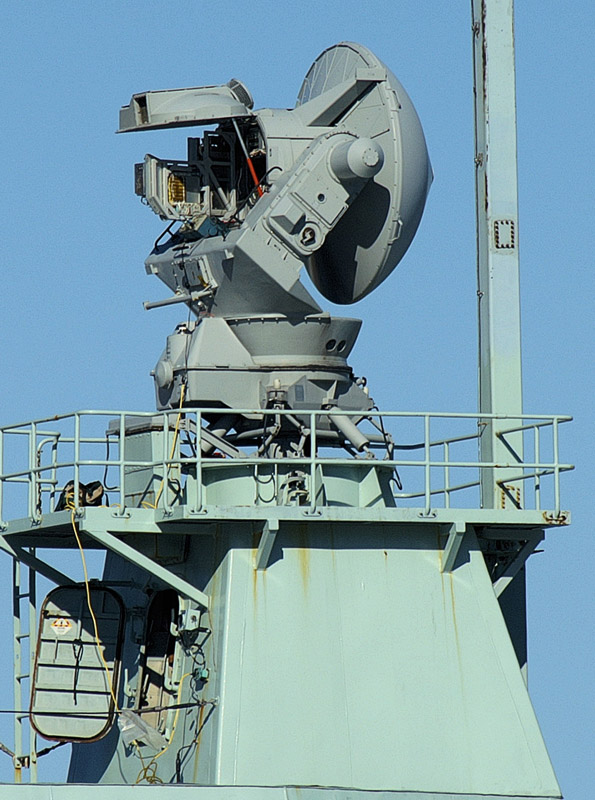 |
| The aft AN/SPG-503 radar has been opened up for maintenance. (Photo
by Sandy McClearn) |
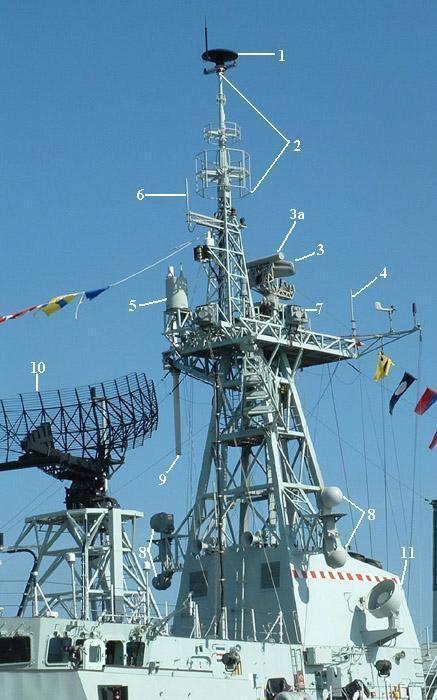
|
Photo # Radio Ant 5. 2005: Foremast antennas and vicinity.
1-
AN/URN-25; 2- AN/SRD-501; 3- AN/SPS-505; 3a -? 4 - Sealand
VHF antenna. 5- AN/ULR-501 (Sea Search). Developed by Condor,
inherited by EDO, then ITT.
SEASEARCH II was the same system, but modified for the Victoria class
submarines. Used to detect and analyze hostile RF emissions. 6
- Sonabouy processor receiver antenna. 7- CANEWS 1 of
4;
8- RAMSES. Fitted on port and starboard sides; 9- UHF
antenna 10- AN/SPS-49 L-band radar;
11- OE-82C/WSC-1 UHF
sat comm. 1 of 2. (Photo by Jerry Proc) |
|
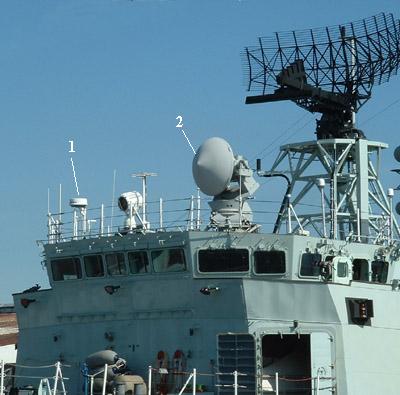
|
| Photo # Radio Ant 6 - Furuno Navigation Radar. 4 kw. Range -
0.25 to 36 nm. 2 - AN/SPG-503 Fire Control radar. There are two
systems, fore and aft. Range is 140 km for a one square metre target. It
operates in the K/I band. STIR = Signaal Tracking and Illumination Fire
Control Radar.
(Photo by Jerry Proc) |
|
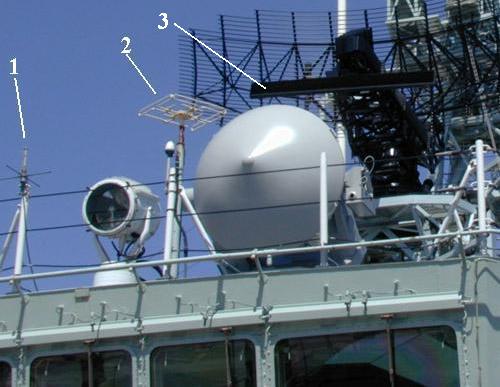
|
| Photo # Radio Ant 7. HMCS Montreal. #1 - unknown;
#2
Television antenna. Now obsolete. Replaced by satellite TV. #3.
AS-2188/UPX IFF Interrogator Antenna for SPS-49(V)5 (Photo
by Sandy McClearn) |
|
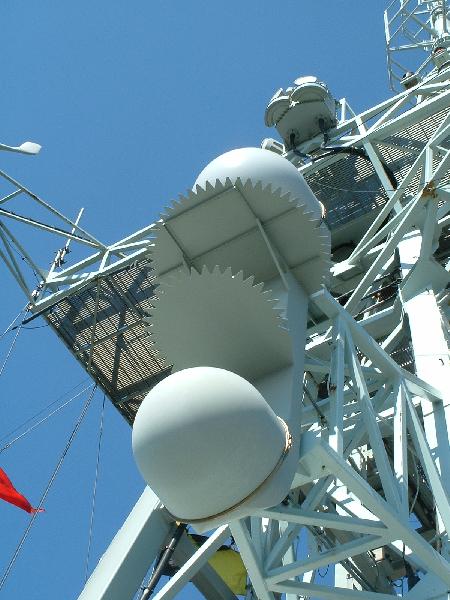
|
| Photo # Radio Ant 8. HMCS Toronto 2005. Closeup of the two port
side RAMSES radomes with one of the CANEWS antennas directly above them.
(Photo
by Jerry Proc) |
Ken Bowering [12] expands on the RAMSES System. " RAMSES (Reprogrammable
Advanced Multimode Shipboard ECM System) is a powerful, software-controlled
radar jammer. It counters the stages of an attack sequence using a variety
of electronic noise and deception techniques, either singularly or in combination,
to frustrate designation and/or target lock-on. If missile lock-on has
already occurred RAMSES causes the missile to lose track of its designated
target. RAMSES provides the ability to simultaneously jam more than one
radar and separate groups of targets can be tracked and jammed by the two
antenna subsystems. lt's ability to counter missiles which employ active
homing techniques establishes its position as an advanced ECM system".
According to the white paper A Brief History of Chinese Naval Radar
and EW Developments, "one dome of the RAMSES device is used to track
the enemy’s ECM emissions while the other is used to jam it. Each pair
of antenna can be used against one target each. The metal plates between
the two domes are baffles to prevent interference. Claimed range is 200
km".
Identification Friend Foe
AN/APX-72 IFF TRANSPONDER
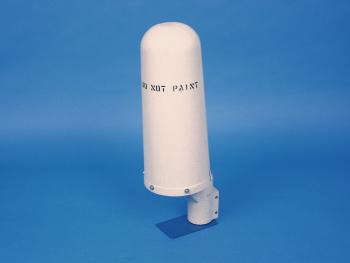 |
| AS-177B/UPX transponder antenna. (Photo courtesy R.A. Miller
Industries)
Its radiating element consists of a full-wave center feed dipole with
a conical skirt to prevent currents from flowing on the supporting mast.
The antenna is enclosed in fiberglass radome which protects the high voltage
points from moisture, dirt, or physical contact and is mounted directly
to a 1-1/2" pipe. Manufactured and qualified to Military Specification
MIL-A-28745.
Power input 5 kw.
VSWR: 1.4 to 1 maximum
Polarization: Vertical
Pattern: Omni-Directional
Frequency: 1030 to 1090 MHz Weight: 8 pounds |
|
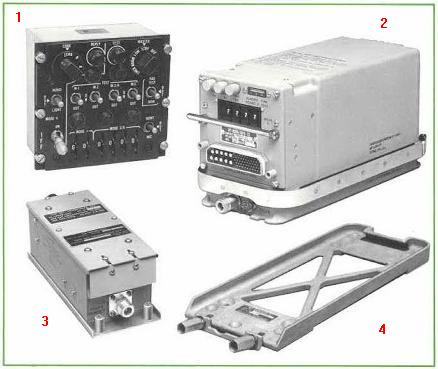 |
| AN/APX-72 Components. 1 - Transponder Control. This control
provides the operator with an illuminated panel for the operation and monitoring
of the transponder functions. 2- RT-RT859A/APX-72. It receives
the IFF interrogation signal, decodes and processes the signal and transmits
the approximate coded reply. 3 - TS-1843B/APX Test Set. It
interrogates the transponder and indicates unsatisfactory performance on
the panel. It will also evaluate the transponder's replies to external
IFF challenges. 4 - Mount MT3809/APX-72. (Image courtesy Columbia
Electronics). |
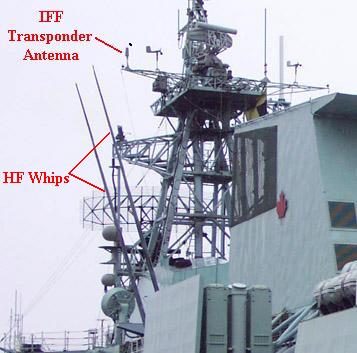 |
| Location of transponder antenna. (Photo
source unknown) |
The Mk XII system is composed of an interrogator (challenge) subsystem
and a transponder (reply) subsystem. The interrogator subsystem permits
a radar operator to interrogate other platforms and to interpret this data
as specific identification of friendly radar targets. The interrogator
subsystem may be either a "black" IFF or a "slaved" IFF. Black IFF is a
"stand alone" interrogator subsystem not associated with any radar system;
only IFF returns can be displayed. With slaved IFF, the interrogator is
synchronized with a radar set. The operator can display IFF only, radar
only, or both.
The transponder subsystem accepts a challenge from other platforms and
provides the necessary coded replies as identification. The transponder
subsystems used aboard ships are aircraft transponder sets adapted for
shipboard use. Most large surface ships are equipped with one transponder
and one or more interrogators. Smaller surface ships are transponder-only
equipped. The MK XII was designed to prevent the transponder from responding
to self-interrogation.
 |
AS-2188/UPX IFF Interrogator Antenna for SPS-49(V)5.
Height: 19 inches; Width 111.5 inches; Depth 20.5 inches
Weight: 74 lbs
Transmit range Frequency: 1030 MHz
Receive Range Frequency: 1090 MHz
Polarization: Vertical
RF Power Rating: 10 kilowatts (Photo courtesy Antenna Associates) |
| No photo available at this time |
AS-2694 IFF Interrogator Antenna for SPS-505. No data
could be located for this antenna type. |
SHIP'S OWN NAVIGATION
GPS RECEIVER ( LATEST)
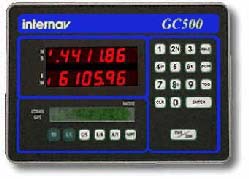
|
Internav CG500 Loran-C/GPS receiver.
(Image courtesy Internav). |
According to Internav, a new navigation receiver, the GC500 (NATO 5825-21-912-2823)
has been installed in the Halifax class frigates. It combines Loran 'C'
and GPS to derive a single optimized position fix. Internav was established
in Sydney, Nova Scotia in 1976. During that time, the company has been
the major supplier to the Canadian Government and to the commercial shipping
and offshore industries in Canada and overseas of precision navigation
aids based upon Internav's proprietary Loran-C and GPS navigation products.
GPS RECEIVER ( EXISTING)
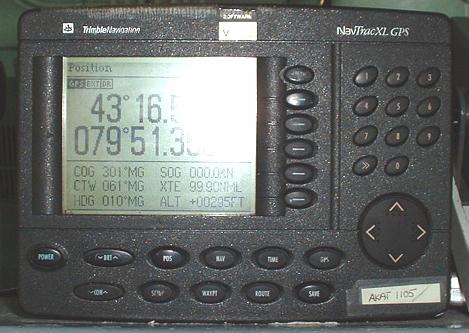 |
| Trimble NavTracXL GPS. Fitted on bridge. (Photo by
Jerry Proc) |
LORAN 'C'
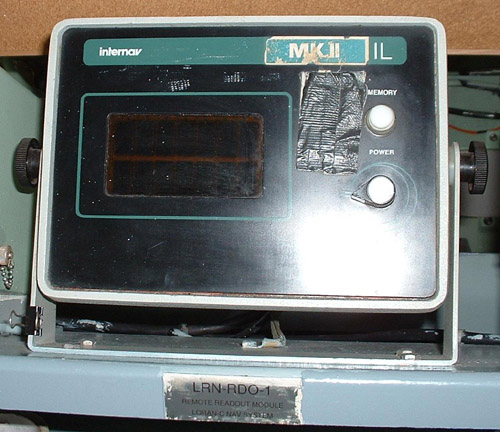 |
| This is the remote readout unit for the Internav Loran 'C' receiver.
Loran 'C' is no longer used for navigation in the RCN. (Photo by Jerry
Proc) |
AIS
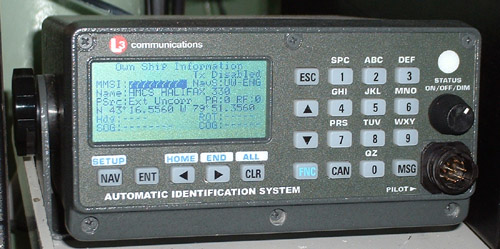 |
| The L-3 Communications Automatic Identification System (AIS) is a collision
avoidance tool, mandated by IMO SOLAS (International Maritime Organization)
(International Convention for the Safety of Life at
Sea),
to improve the situational awareness of the bridge crew while facilitating
communication between vessels. It also has a 12 channel built-in GPS receiver.
In this case, the ship is broadcasting its name "HMCS Halifax 330". Other
ships similarly equipped will also broadcast their name and it will show
up in the display. Note the coordinates of N 43° 16.5560 , W
79°51.3560 are those of the western portion of Pier 9 in Hamilton.
The photo was taken on May 4/07 when HMCS Halifax was in Hamilton. (Photo
by Jerry Proc) |
DEPTH RECORDER
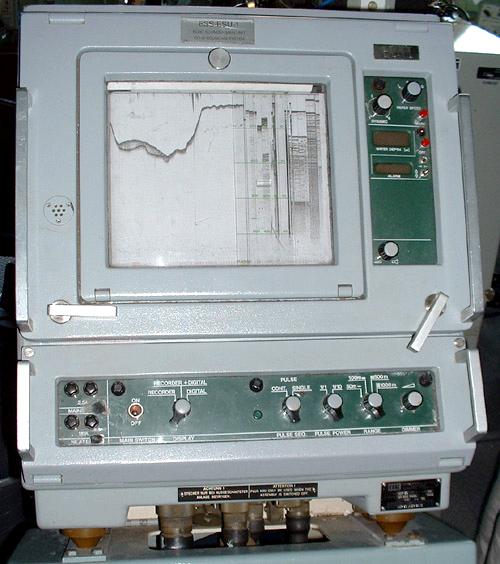 |
| The depth recorder is situated on the bridge. Does anyone know the
maximum depth that this unit can detect? (Photo by Jerry Proc) |
NAVIGATION FOR SHIP'S HELICOPTER
AN/URN-25 TACAN
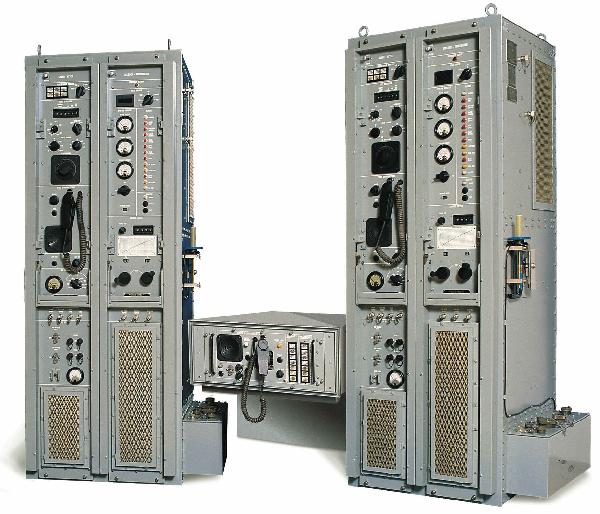 |
| The AN/URN-25 TACAN Transponder Group is a full service transponder,
providing TACAN-equipped aircraft with range, bearing, and identification
within a 300 nm radius. This navigation aid was fitted to Annapolis 266
and the 280 class ships. It is currently used in the Halifax class patrol
frigates. Pictured above is a dual installation with automatic switch over
to the standby unit in case the primary unit fails. In between the transponders
is the control unit. (Photo and specifications courtesy NavCom Defence
Electronics) |
FEATURES:
* All solid state except for the ceramic triode tubes in the transmitter
output stage.
* All band capability X and Y mode. 252 channels available.
* Emergency power levels of 700 and 150 watts available in case of
transmitter tube failure
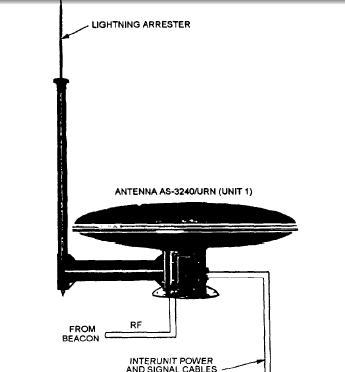 |
| OE273/AS3240 TACAN antenna. Nothing spins in this antenna. All elements
are controlled electronically. This antenna is found on the foremast
peak. (Image courtesy Global Security web page) |
SPECIFICATIONS:
Major Units: Transponder Group OX-52/URN-25 and the Control-Indicator
C-10363/URN-25
Transmitter: Power output: 3,000 watts at end of tube life.
700 watts reduced power mode (selectable)
700 and 150 watts for emergency power level.
Antenna Group: OE-273A(V)/URN / AS3240
Power Input: 115 volts 45 Hz to 450 Hz.
Weight: Transponder - 960 lbs( 436 kg)
Status Control Indicator - 75 lbs (34 kg)
Dimensions : Transponder Cabinet only - 66" H x 26" D x 24" W
Manufacturer: NavCom Defence Electronics.
El Monte, California
Credits and References:
1) Sandy McClearn <smcclearn(at)ns.sympatico.ca>
2) NavCom Defence Electronics http://www.navcom.com/navigation_systems.htm
. El Monte, California
3) RCN Industry Day Presentation November 15, 2006. Ottawa
Ont. on-line PPF file
4) AS-177 Antenna R.A. Miller Industries http://www.rami.com/
5) Mk XII Info http://www.globalsecurity.org/military/library/policy/navy/ntsp/Aims-mk-xii-iff.htm
6) APX-72 photo . Columbia Electronics. http://www.columbiaelectronics.com/index.htm
7) AS-2188 photo Antenna Associates http://www.antennaassociates.com/datasheets.html
8) Kelvin Hughes 1007 http://www.adi-limited.com/pdfs/ADI6796MinehunterWeb.pdf
9) Internav http://www.randburg.com/ca/internav.html
10) RAMSES - A Brief History of Chinese Naval Radar
and EW developments pg 35. http://www.china-defense.com/naval/plan_radar_ew/PLA-N%20Radar%20and%20EW.pdf
11) http://www.fas.org/man/dod-101/sys/ship/weaps/an-sps-49.htm
12) Ken Bowering. "Canadian Naval Electronic Warfare:
A Review and Update". January 1986
13) Robert Langille <ewcs(at)ewcs.ca>
Web: http://www.ewcs.ca/
Back to Halifax Class
June 27/12















